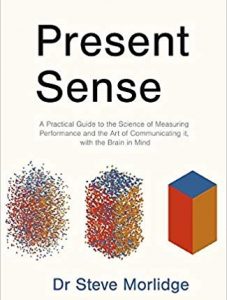 It's no secret that The BFD is a huge fan of Steve Morlidge.
It's no secret that The BFD is a huge fan of Steve Morlidge.
Morlidge has contributed work of fundamental importance to our understanding of the practice of business forecasting. His studies of forecast quality exposed the abysmal nature of the practice, including the startling statistic that perhaps 30-50% of real-life forecasts – that business are using to make decisions – are less accurate than a naive no-change forecast. Morlidge introduced the concept of avoidable error, and through his consulting and software development, has created ways for organizations to pinpoint opportunities for improvement, and make that improvement happen.
In this 3-part series of excerpts, adapted from his new book Present Sense (Matador, 2019), Morlidge returns to his roots in performance reporting. Drawing on theories of data visualization and the latest insights from cognitive science, he lays out an approach to reporting that exploits the physiological strengths of our brains and compensates for its weaknesses.
Present Sense is about how to present data in a way that makes sense – that communicates meaning effectively to decision makers. While the book covers the broad topic of performance reporting, these excerpts particularly apt for the professional who must communicate forecasts to organizational management.
The orthodox recommendation has long been to communicate by storytelling – to wrap complex information in a conveniently understandable and unambiguous narrative that neatly explains everything. But Morlidge rejects the storyteller approach. Instead, the forecaster must communicate like a reporter – fairly spelling out the facts as known at the time, expressing them simply, but with all their requisite ambiguity. Forecasting is, after all, an exercise in uncertainty. Disguising – or ignoring – that uncertainty does a disservice to those relying on the forecast for their decision making.
Part 1: Not Storytellers But Reporters
Human beings have the desire for things to ‘make sense’ – even when we don’t have the information to do more than make a guess. This is the reason we like stories. It has been proven that the less we know the more confident we are of our opinions (the Dunning-Kruger effect) probably because it gives us more latitude to bend the ‘facts’ to fit our prejudices.
Stories neatly explain what happened and why, with simple cause and effect relationships, populated by ‘goodies’ and ‘baddies’ with simple motivations. We (or at least part of us) are uncomfortable with ambiguity and dislike suspending judgement or giving multiple competing interpretations equal weight. This is why intelligent people construct stories about ‘why the market moved today’ even when they and their audience know that they are just making things up. Understanding the motivation of even one person is difficult. How can anyone read the mind of thousands of market agents whom they have never met, particularly since many of them are machines. We want something that isn’t possible in real life: absolute certainty. Even better if the story we create confirms our pre-existing opinions and prejudices.
Imposing order on and attributing meaning to a complex and fast-moving reality is the primary goal of information professionals. But it is at least as important – at the same time – to find ways to help your audience appreciate the highly provisional and contingent nature of any attempt to impose a simple explanation on a complex, dynamic and fundamentally unknowable world where ambiguity is rife.
All the traditional tools of the trade, like variance analysis, are already biased towards simple binary judgements that provide no scope for argument. Instead of finding new ways to drive out uncertainty, we should be encouraging people to perceive the world in a more holistic way and become more open to ambiguity. In particular, both learning and assessing risk – highly desirable traits in business – require us to take much more notice of things that don’t make sense in the context of our current mental models.
This is why I flinch whenever I hear people describing that they want information professionals to ‘tell stories’. Granted, stories are powerful. They are clear and compelling. Too much so. They have a beginning and an end and a simple clear narrative that can only be interpreted in one way. Stories tell you what and why. There is no scope for alternative explanations or for doubt. And I think that is dangerous.
